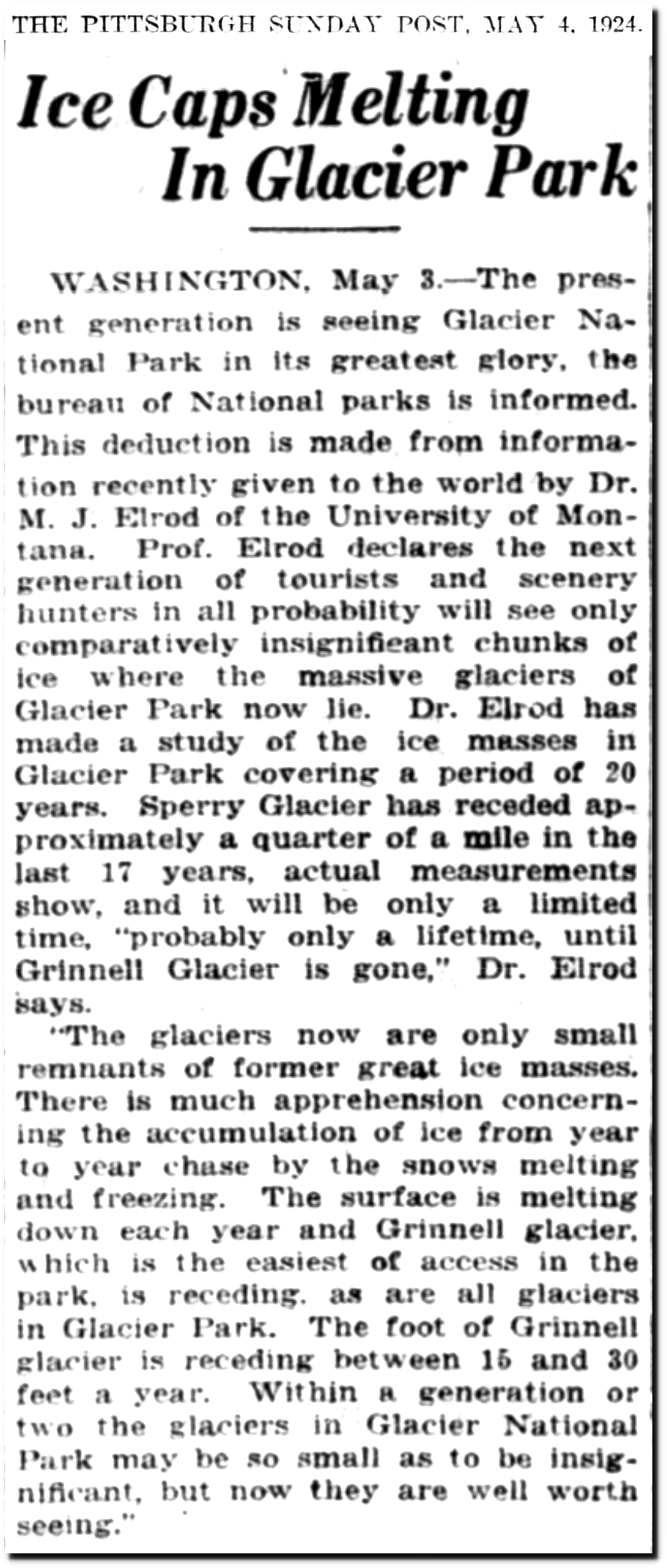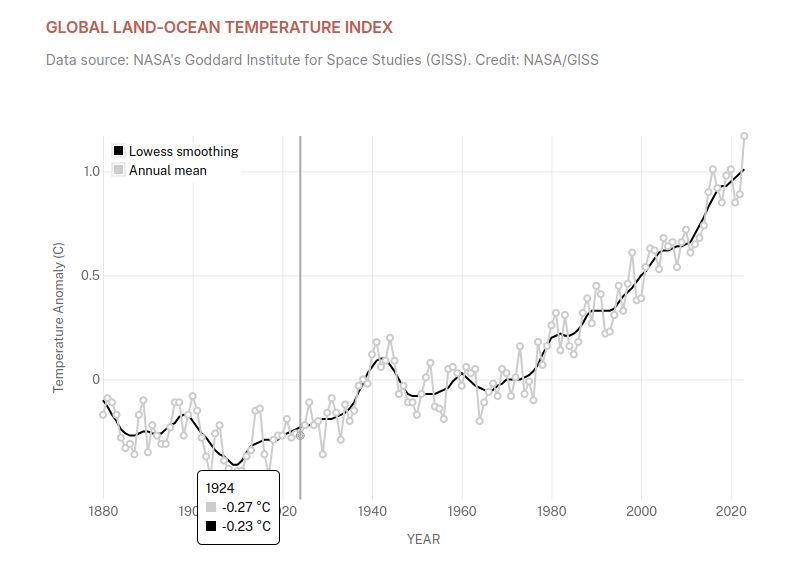The National Park Service has a website showing glacial retreat in Glacier National Park since the early 20th century, but they forgot to mention that most of that retreat occurred before 1935.
Glacier Repeat Photos – Glacier National Park (U.S. National Park Service)
“Sperry glacier in 1900 had a surface area of 840 acres. By 1938 the area had shrunk to 390 acres, and in 1946 to about 330 acres. Even more significant is the lowering of the glacier’s surface. In 1938 Sperry glacier had a thickness of 108 feet at the site of the 1946 ice margin. At this same place in 1913 the thickness was nearly 500 feet, and the average thickness of the glacier over the area from which it has since disappeared at least 300 feet. The average thickness of Grinnell glacier in 1937 at the site of the 1946 ice front was seventy-three feet. The surface of the entire glacier was lowered fifty-six feet during that 9-year period. This means that each year the glacier was reduced in volume by an amount ‘of ice equivalent to a cube 450 feet high. Thus the volume of Grinnell glacier was reduced by about one-third from September, 1937, to September, 1946.
One Is Almost Gone.
“Several other glaciers have exhibited more — phenomenal shrinkage than Sperry or Grinnell. The topographic map of Glacier National park. prepared in 1900-1902, shows several comparatively large glaciers such as Agassiz, Blackfoot and Harrison. Their shrinkage has been so pronounced that today Agassiz has virtually disappeared and the other two are pitifully small remnants”
05 Sep 1952, 34 – The Kansas City Times at Newspapers.com
“THE PITTSBURGH SUNDAY POST, MAY 4. 1924.
Ice Caps Melting In Glacier Park
WASHINGTON, May 3.—The present generation is seeing Glacier National Park in its greatest glory, the. bureau of National parks is informed. This deduction is made from information recently given to the world by Dr. M. J. Elrod of the University of Mon-tana. Prof. Elrod declares the next generation of tourists and scenery hunters In all probability will see only comparatively insignificant chunks of ice where the massive glaciers of Glacier Park now lie. Dr. Elrod has made a study of the ice masses in. Glacier Park covering a period of 20. years. Sperry Glacier has receded approximately a quarter of a mile in the last 17 years, actual measurements show, and it will be only a limited time, “probably only a lifetime, until Grinnell Glacier is gone,” Dr. Elrod says.
“The glaciers now are only small remnants of former great ice masses. There is much apprehension concerning the accumulation of ice from year to year chase by the snows melting: and freezing. The surface is melting. down each year and Grinnell glacier, which is the easiest of access in the park, is receding. as are all glaciers in Glacier Park. The foot of Grinnell glacier is receding between 15 and 30 feet a year. Within a generation or two the glaciers in Glacier National Park may be so small as to be insignificant, but now they are well worth seeing.”
04 May 1924, Page 33 – Pittsburgh Daily Post at Newspapers.com
“Glacier Park Melting at a Rapid Rate in Scientist’s Opinion
CINCINNATI, Dec. 29.—(By the Associated Press)—The hot dry seasons of the past few years have caused rapid disintegration of glaciers in Glacier National park, Montana, professor W. G. Waterman of Northwestern university declared in an address today before the geological section of the American Association for the Advancement of Science.
Grerry glacier, studied by Professor Waterman, has lost one-quarter, or perhaps one-third of its ice in the past 18 years, he said. If this rapid retreat should continue, the professor added, the glacier would almost disappear in another 25 years”
29 Dec 1923, Page 5 – at Newspapers.com
(99+) GLACIERS OF THE CONTERMINOUS UNITED STATES | Richard Menicke and Carl Key – Academia.edu
According to NASA and the IPCC, this rapid retreat was during the coldest years on record.
Global Temperature | Vital Signs – Climate Change: Vital Signs of the Planet












and the remaining 198,000 glaciers in world
the park literature clearly states that those glaciers are only 3,000 to 4,000 years old. they are not remnants from the last ice age. Apparently it was warmer 5000 years ago
+1
It was warmer 5,000 years ago. It was near the end of the warm period known as the Holocene Climatic Optimum.
….but they forgot to mention that most of that retreat occurred before 1935.
We climate realists are so polite and pleasant; we appear to allow the benefit of the doubt, even if in sarcasm. I chalk it up to an slow-moving, overwhelming globalist Agenda, which has been openly spoken about for decades, and which has infected every government agency over the decades. All of these kinds of omissions are on purpose. That is the opinion of this since-educated former believer in the Climate Scam.